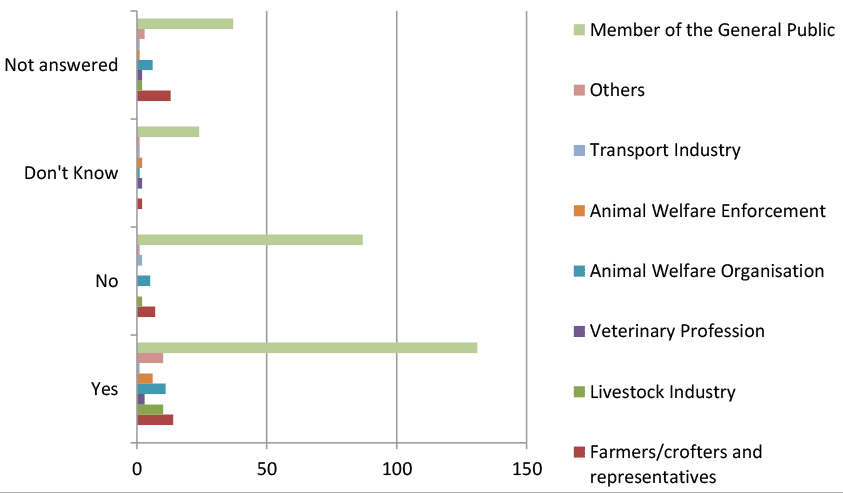Welfare of animals during transport - consultation: summary report
Analysis of the responses received to the full public consultation, between 4 December 2020 to 26 February 2021, of the Farm Animal Welfare Committee's opinion on the welfare of animals during transport.
Question 3
Do you agree with the Scottish Government’s position on determining fitness for transport and proposed course of action? Please provide any further relevant information.
The Scottish Government considers that owners, transporters and farmers should be supported to understand fully how to provide for, and comply effectively with high standards of welfare in transport. We agree that well-developed and well-designed best practice guides can play an important role here, and we agree that they could be applied and promoted by the industry and government, including by levy boards.
We support the use of a wide variety of tools and channels to convey helpful information in timely and user-friendly ways, as part of raising awareness, supporting compliance, and improving dialogue and understanding.
We agree that guidance and other supporting material should reflect the latest understanding and best practice, and should be sufficiently detailed. We also agree the current definition of fitness for transport could be reviewed with the aim of developing an improved and more specific version.
Effective enforcement and the timely application of suitable penalties plays an important role in preventing poor and harmful practice and in incentivising compliance. We note FAWC’s recommendations here and will respond to them as part of responding to FAWC’s later recommendations on enforcement (See Q.16).

Of the 323 responses to this question, 57.6% were in favour of the Scottish Government’s position on determining fitness for transport and proposed course of action. 32.2% were not in favour and 10.2% did not express a view.
Most respondents agreed that the fitness of an animal to travel is of high importance, irrespective of whether they favoured the Scottish Government’s proposed course of action or not. A number of respondents also suggested agreement with the FAWC Opinion that “transporting animals unfit for travel is by far the most common form of non-compliance” (unnamed organisation). The National Beef Association suggested that “further scientific research is required in this area”.
There was also a high level of agreement with the Scottish SPCA’s comment that “those involved in the care prior to travel and those involved in the transport of animals should be suitably trained and qualified in identifying the welfare of animals in their care”. The Road Haulage Association Ltd noted the current existence of best practice guidance, and also certificates of competence required by a number of assurance schemes, which “along with experience gained transporting livestock enables drivers to determine whether an animal is fit to travel”.
Scotland’s Rural College pointed out additional issues “about responsibility (the haulier or the farmer) in making these decisions” on fitness to travel and noted that “in some cases haulier’s may be acting in good faith” if loading animals in poor light or other situations where welfare issues might not be clear.
A number of respondents agreed with FAWC that “best practice guides such as the EU Animal Transport Guides should be applied and promoted by the industry and government” (Animal Aid). OneKind considered that these might have “not been well utilised in the UK” and suggested their relaunch and promotion. Some other respondents noted that guidance is not available for all species and that this could be considered.
It was also commented by a number of respondents from enforcement agencies that “farmers and hauliers are well aware of what is and is not fit for transport” (Argyll & Bute Council) and of the need to consult a qualified veterinary surgeon if in doubt. However, it was also suggested that there may be benefit in providing “a wider range of specific descriptions e.g. for lameness and … to review the provision to allow the transport of an animal who is ‘Slightly’ injured” (Scottish Animal Health & Welfare Panel). In addition, it was suggested that “double checking that hauliers who are new to the job are properly trained” (East Ayrshire Council) could be carried out.
A number of respondents from the Northern Isles, while mentioning that determining fitness to travel is “always going to be somewhat subjective”(MA & DS Groat), gave favourable mention to the current transport practices between the Isles and Aberdeen where local authority officers determine fitness to travel at both ports of embarkation and disembarkation. This whole process was suggested as retaining “the welfare of animals as a core value of the local industry” (Shetland Islands Council).
Members of the poultry industry highlighted their joint work with the airline industry to “produce a global guide to best practice for air transporting of hatching eggs and day old birds” (British Poultry Council). The Scottish Animal Welfare Commission suggested that assessment of poultry was problematic and suggested that “further work or guidance may need to be developed” for the poultry sector.
A proactive approach to underline the importance of welfare in transport was suggested and a specific section in required animal transport forms be inserted to aid consideration of welfare at point of loading. As stated by Nourish Scotland “this is not about catching farmers out, but simply providing a prompt to remember the importance of doing this right”.
A number of respondents from the farming sector suggested that “guidance could be developed in partnership with industry, encouraging buy-in and support” (NFU Scotland) from the sector with another unnamed sectoral organisation also suggesting the need for veterinary input. Compassion in World Farming commented that “animal protection organisations with relevant experience” should also be involved in drafting formal guidance.
Contact
There is a problem
Thanks for your feedback